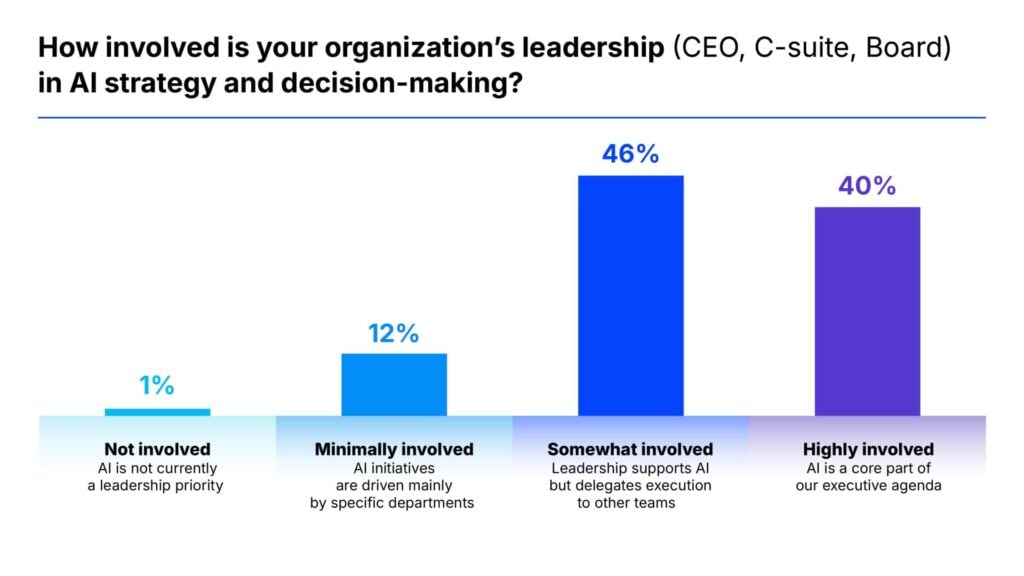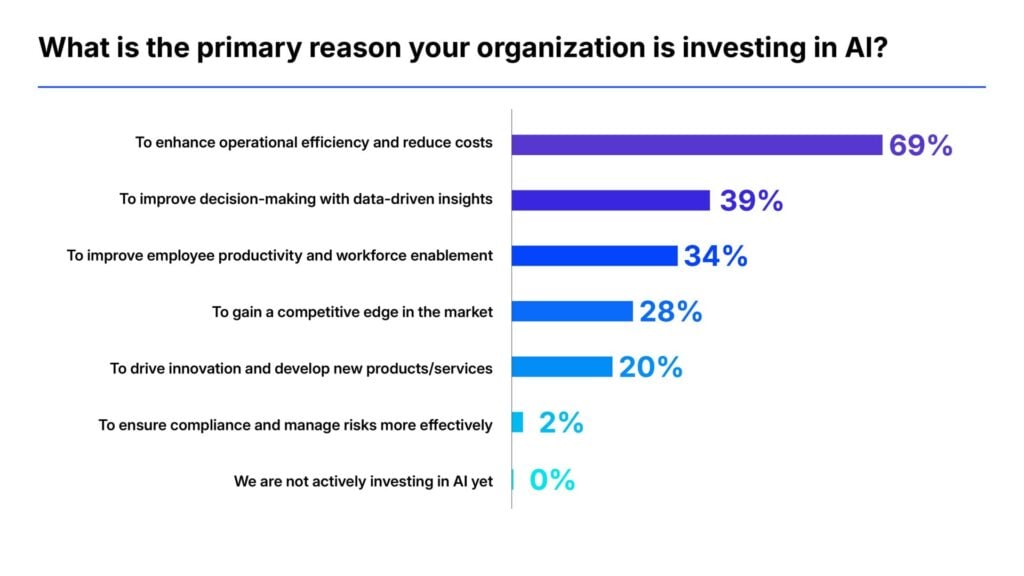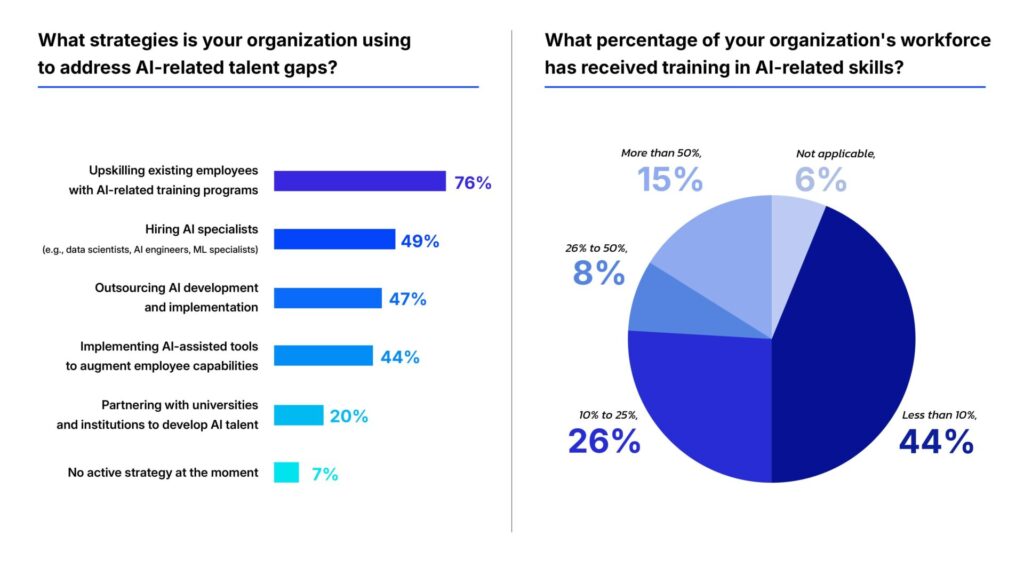Creating sustainable business value from AI requires more than adoption — it requires coordinated progress across people, processes, and technology.

AI Transformation: A Strategic Imperative for Forward-Looking Organizations
Across Thailand, leading organizations are repositioning AI Transformation as a core strategic mandate. But embedding “AI” in the corporate strategy is not enough to ensure an AI-driven organization. Real transformation requires synchronized progress across people, processes, and technology, enabling AI to scale seamlessly and continuously across the enterprise.
Although AI adoption is well underway, most organizations still operate within the boundaries of efficiency and cost optimization. These gains are important, yet only foundational. The next frontier of value lies in enterprise-wide AI scalability, enabling organizations to:
- innovate at speed,
- differentiate competitively, and
- strengthen enterprise risk intelligence.
Organizations that move beyond isolated use cases and scale AI into the core of their operating model will be positioned to capture the next wave of transformational growth.
Even though most organizations have started using AI… they are struggling to scale.
According to Thailand’s AI-Driven Leadership Report 2025 by Bluebik Group—based on insights from over 100 leading organizations nationwide—the current state of AI adoption in Thailand can be seen clearly:
- Over 97% of Thai organizations have already begun adopting AI
- More than half are still in the pilot project phase
- 16% remain at the stage of exploring and evaluating potential use cases
- Only 29% have managed to scale AI across the enterprise
The survey illustrates a clear reality: although most Thai organizations recognize the importance of AI and have already begun adopting it, few have been able to operationalize AI at scale or extend its impact across the enterprise.

At the same time, the survey highlights a strong positive shift. AI is rapidly moving beyond a technical initiative and evolving into a strategic enterprise priority, attracting greater attention, ownership, and sponsorship from senior executives across organizations.
From Only Efficiency Gains to Enterprise Value Creation with AI
Although most Thai organizations have begun adopting AI over the past two years, their efforts remain primarily focused on improving operational efficiency and reducing costs—an essential but early step in the broader AI Transformation journey.

The next milestone is far more strategic: expanding AI’s role from a supporting tool to a core engine of organizational growth, driven by four key objectives:
- Enhancing workforce productivity and capability across all levels
- Embedding AI into core business operations to build intelligent, adaptive, and resilient processes
- Driving innovation through new products, services, and business models
- Enabling AI-driven decision-making, powered by real-time data and advanced analytics
AI now stands at a defining turning point—shifting from “using AI to improve efficiency” to “using AI to create meaningful enterprise value.” Organizations must decide whether they will remain adopters of AI or truly evolve into AI-driven enterprises capable of scaling transformation across the business.
People: Capability and Alignment as the Starting Point of AI Transformation
While organizational leaders are increasingly aware of AI’s strategic importance, many still face significant constraints stemming from skill and capability gaps—a foundational barrier to operationalizing AI at scale.
The survey reveals that:
- 40% of AI initiatives in Thailand are led by IT, CIO, or CTO functions
- Only 11% of organizations have dedicated AI leadership, such as a Chief AI Officer or an AI Strategy Team

These findings highlight a critical truth: AI success depends on clear alignment between leadership and the workforce. Technical skills alone are no longer sufficient. Organizations need leaders who can cohesively connect strategy, business priorities, and technology capabilities, ensuring that AI becomes a sustainable driver of enterprise-wide transformation.
Process: Governance as the Engine of Enterprise-Scale AI
While many organizations adopt AI to improve efficiency, scaling AI across the enterprise requires robust, transparent, and adaptable governance—a system capable of supporting rapid change and ensuring responsible use of AI throughout the organization.
The survey reveals that:
- Only 15% of Thai organizations have a clear AI governance framework
- 40% are still in the process of developing one
- 18% rely on third-party guidelines
- And notably, 30% say AI risk management is not yet an urgent priority
Bluebik highlights that the absence of proper AI governance exposes organizations to three critical risks:
- Regulatory compliance and data ethics
- Customer trust and brand credibility
- Cybersecurity and data protection vulnerabilities
Going forward, governance will become a fundamental pillar of cybersecurity resilience. Any organization aiming to become truly AI-driven must embed governance from the outset—spanning data governance, risk management, and regulatory alignment—to ensure AI can be scaled safely and sustainably.
A further challenge identified is the way organizations measure AI success. Many continue to assess impact primarily through productivity gains and ROI, while factors such as customer experience, innovation, and regulatory compliance remain secondary.

However, measuring the true value of AI requires broader dimensions—such as customer experience, employee adoption, and innovation impact—to reflect value creation more holistically, beyond financial metrics that may take time to materialize.
Technology: AI’s Shift from Tools to Core Enterprise Capabilities
Technology remains the fastest-advancing dimension of AI adoption in Thailand, yet most organizations continue to rely heavily on external systems and third-party platforms.

While external technologies can accelerate early adoption, long-term overreliance prevents organizations from developing the core AI capabilities needed for competitiveness, resilience, and effective model quality control.
Bluebik recommends that organizations begin building their own Core AI Capabilities through four strategic approaches:
1. National Infrastructure Ownership: Build sovereign data and AI model infrastructure to ensure resilience, security, and continuity under all circumstances—including emergencies or geopolitical disruptions. Even when leveraging third-party infrastructure, organizations should establish clear controls over data storage, access, and governance.
2. Foundation Model Development (Small Language Models, Not Large Ones): Developing Large Language Models to compete globally may not be feasible, but organizations can build Small Language Models (SLMs) tailored for niche markets or specialized domains. Combining SLMs with open-source frameworks enhances agility, reduces development costs, and creates targeted value.
3. Model Customization: Develop in-house capability to fine-tune AI models for Thai language, local contexts, and industry-specific challenges. Customization not only increases accuracy but also creates differentiation and ensures models align closely with an organization’s business environment and strategic priorities.
4. AI Application Integration: Beyond relying on off-the-shelf solutions, organizations should develop AI-powered applications embedded directly into core business workflows. Building AI applications internally strengthens strategic control, unlocks greater flexibility, and accelerates innovation within the enterprise.
Conclusion: From Initial Adoption to Achieving AI Scalability

The survey underscores a critical reality: while most Thai organizations have already entered the AI adoption phase, the next major milestone in their transformation journey is achieving AI Scalability. Reaching this milestone requires more than isolated projects — it demands readiness across people, processes, and technology, which together form the foundation for scaling AI sustainably across the enterprise.
For Thai organizations, adoption is only the beginning. The path toward AI Scalability calls for committed leadership, a workforce ready to evolve alongside technology, and a resilient infrastructure capable of supporting continuous growth and innovation.
True AI Transformation is not defined by the number of initiatives or the level of investment alone. It is defined by an organization’s ability to align and elevate its people, processes, and technology into a cohesive system—one that unlocks the full potential of AI and enables the enterprise to mature into a truly AI-driven organization.










![Thumbnail [Post Event] HOW](https://bluebik.com/wp-content/uploads/2025/12/Thumbnail-Post-Event-HOW.png)

